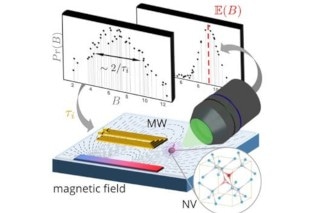May 3 2019
Scientists at the University of Bristol have attained new levels of advancement in the detection of magnetic fields with exceptional sensitivity at room temperature through the integration of a quantum sensor with machine learning.
 Figure showing the electron spin in the Nitrogen-Vacancy center in a diamond together with the main steps of the machine learning protocol used by the scientists for this experimental demonstrations. (Image credit: University of Bristol)
Figure showing the electron spin in the Nitrogen-Vacancy center in a diamond together with the main steps of the machine learning protocol used by the scientists for this experimental demonstrations. (Image credit: University of Bristol)
The study outcomes have been reported in Physical Review X and could result in a new generation of MRI scanners that employ radio waves and magnetic fields to create detailed images of the inner body, and also further potential applications within material science and biology.
These outcomes were accomplished with the help of a combination of quantum sensing devices and machine learning methods—in which computers adapt and learn from experience similar to what humans and animals do naturally.
Scientists at the Quantum Engineering and Technology Labs (QETLabs) at the University of Bristol, collaborated with the Institute for Quantum Optics of the University of Ulm and Microsoft to show this using a quantum sensor based on the electron spin in a nitrogen-vacancy (NV) center in a diamond.
NV centers are atomic flaws that can be spotted or created in a diamond. They enable interaction with single electrons, which can be used in turn to sense electric and magnetic fields. Their exclusive combination of high sensitivity and spatial resolution has enabled the analyses of scenarios in which the activity of single neurons is monitored and mapped down to the nano-level. But nanoscale nuclear magnetic resonance applications such as these are restricted by the noise of the optical readout that exists at room temperature in sophisticated setups.
We expect that the deployment of our techniques can unlock unexplored regimes in a new generation of sensing experiments, where real-time tracking and enhanced sensitivities are crucial ingredients to explore phenomena at the nanoscale.
Dr Anthony Laing, Lead Researcher, University of Bristol.
Here we show how machine learning can help overcome these limitations to precisely track a fluctuating magnetic field at room temperature with a sensitivity typically reserved for cryogenic sensors.
Dr Raffaele Santagati, Research Associate, Centre for Quantum Photonics, University of Bristol.
“In our paper, we show how a Bayesian inference approach can successfully learn the magnetic field and other physical important quantities from naturally noisy data. This allows us to relax the complexity of the data readout process at the cost of advanced data processing,” stated Antonio Gentile, study co-author.
Although nitrogen-vacancy centers that exist in diamond defects have been used even before in demonstrating their sensing potentials, noise and undesirable interactions can restrict their applicability to real-world scenarios. The results of this study indicate ways to overcome these restrictions.